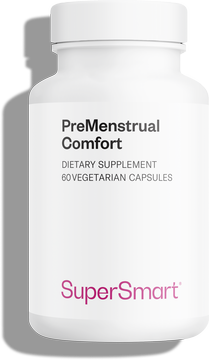How should different foods be cooked to preserve their vitamins and nutrients?
While the concept of cooking food marked a turning point in the history of mankind by increasing the bioavailability of a lot more nutrients, it can also be responsible for destroying vitamins. Read our advice on the best cooking methods for preserving all your food’s vitamins and nutrients.

Cooking at the origins of humanity
Since 2009/2010, many primatologists and palaeologists have agreed on how important mastering fire and cooking food was to mankind’s development of (1).
In fact, cooking makes the macronutrients present in food, especially the protein and carbohydrates (particularly fibre), more digestible and bioavailable, and ultimately maximises the calorie intake of the food consumed (2).
As a result of this development, humans spent less time chewing and looking for food . Their jaws narrowed, allowing more space for the brain to develop, and they were able to devote time and energy to creating ritual, artistic and social practices, etc. Cooking can thus be said to mark the real birth of Humanity.
However, it has also brought some disadvantages. So, after 2 million years of evolution, perhaps it’s now time to use our acquired knowledge to adopt beneficial ways of cooking which preserve all our food’s vitamins and nutrients.
The right way to cook food – pay attention to the oil!
Before we consider what becomes of the vitamins, minerals and other nutrients during cooking, let’s first look at what happens to fatty acids when we heat an oil (3).
Once an oil’s ‘smoke point’ has been exceeded, its fatty acids break down. Not only are their benefits destroyed, but they produce compounds which are potentially toxic for the body. So when it comes to cooking, despite its high omega-3 content, swap your rapeseed oil for olive oil, grape seed oil, soya oil or coconut oil, all of which are able to withstand the high temperaturesgenerated by pan-frying or cooking in a wok.
Which temperature and which cooking method for which vitamin?
Now what about vitamins, so sensitive to the effects of cooking. In fact, the majority of vitamins present in food, especially fruit and vegetables, are destroyed by cooking’s high temperatures, as the following table shows (4):
| Nutrient | Degradation temperature |
| Vitamin A | 110°C |
| Vitamin B | 120°C |
| Vitamin C | 60°C |
| Vitamin D | 110°C |
| Vitamin E | 120°C |
| Mineral salts | 100°C |
A number of conclusions can be drawn from this summary of cooking temperatures and their impact on vitamins:
- vitamin C is the most sensitive and delicate of all the vitamins: so in order to gain maximum benefit from it, it’s strongly recommended that you eat fresh, raw fruits and vegetables every day (lamb’s lettuce, red cabbage, kiwi fruit, etc.) to ensure a good daily intake of vitamin C;
- the more intense and lengthier the cooking process, the more other vitamins will be destroyed. The best way of preserving vitamins and minerals is therefore to opt for fast but gentle cooking.
Steaming and wok-frying for preserving nutrients
It appears there are two optimal cooking methods for producing dishes that are not only full of flavor but also rich in vitamins (5):
- cooking in a steamer basket: the temperature used for steaming does not exceed 100°C and can be used to cook most vegetables al dente in just a few minutes. Be careful with pressure cookers though: while the food cooks more quickly, the temperature reaches 120°C, destroying all the vitamins;
- wok-frying with a little fat is an extremely fast way of cooking crispy vegetables. Although it involves high temperatures, it takes very little time, thus preserving all the vegetables’ vitamins. What’s more, you benefit from the Maillard reaction which produces crispy, caramelised vegetables. But as we’ll see, it’s important not to overdo this aspect …
To our meat-eating friends: beware the Maillard reaction!
“There’s nothing quite like a good piece of meat, well-grilled on the outside, with its caramelised juices forming a delicious crust that keep all the meat’s juices inside”, our carnivore friends tell us. And they’re right … as far as taste is concerned. But from a dietary or health point of view, it’s a somewhat different matter.
Bread crust, hints of malt, caramel and gingerbread: discovered at the beginning of the 20th century by the French chemist who gave it its name, the Maillard reaction is the creation of specific compounds produced when sugars and proteins combine. Now while these Maillard reaction-induced compounds may be mouth-watering, they are medically problematic (6).
Indeed, they are also known as Advanced Glycation End products (AGEs). On average, 10% of these AGEs accumulate in the body and at excessive levels, can cause adverse effects and thus contribute to aging (7).
So while it’s fine to occasionally eat grilled/roasted/barbecued meat, it’s important not to overdo it ! You can also mitigate the effects of AGEs by taking a banaba extract (a plant which helps to metabolise glucose), carnosine (an amino acid extensively studied by glycation specialists), benfotiamine (a form of vitamin B1 which is good for the heart), etc. Certain targeted dietary supplements contain all these compounds (such as Anti-Glycation Formula).
SuperSmart ADVICE
References
- CHIRINOS, Maria Pia. Cooking and human evolution. In : The Hand. Springer, Cham, 2017. p. 147-161.
- BUGIANESI, R., SALUCCI, M., LEONARDI, C., et al.Effect of domestic cooking on human bioavailability of naringenin, chlorogenic acid, lycopene and β-carotene in cherry tomatoes. European journal of nutrition, 2004, vol. 43, no 6, p. 360-366.
- ALFAIA, Cristina MM, ALVES, Susana P., LOPES, Anabela F., et al.Effect of cooking methods on fatty acids, conjugated isomers of linoleic acid and nutritional quality of beef intramuscular fat. Meat Science, 2010, vol. 84, no 4, p. 769-777.
- TYAGI, S. B., KHARKWAL, Mamta, et SAXENA, Tanushri. Impact of cooking on nutritional content of food. DU Journal of Undergraduate Research and Innovation, 2015, vol. 1, no 3, p. 180-186.
- TYAGI, S. B., KHARKWAL, Mamta, et SAXENA, Tanushri. Impact of cooking on nutritional content of food. DU Journal of Undergraduate Research and Innovation, 2015, vol. 1, no 3, p. 180-186.
- ELLIS, G. P. The maillard reaction. In : Advances in carbohydrate chemistry. Academic Press, 1959. p. 63-134.
- HORIUCHI, S., ARAKI, Norie, et MORINO, Yoshimasa. Immunochemical approach to characterize advanced glycation end products of the Maillard reaction: evidence for the presence of a common structure. Journal of Biological Chemistry, 1991, vol. 266, no 12, p. 7329-7332.
Keywords
4 Days
Great customer service - responsive …
I ordered from them and my item was unavailable for sometime. I was super happy when they reactivated my order and shipped my item which arrived very quickly. Great customer service.
Ruth Rueter
5 Days
Super fast shipping
Super fast shipping
Donald Borling
8 Days
Reputable companysearch and the number of…
The research and the number of selection of products.
NAKHJAVAN Shervin
21 Days
The Anti Aromatase is a great product
The Anti Aromatase is a great product. You just need to have constant inventory. Recently this product has been out of stock.
GEORGE Verne
23 Days
Great help on chat
Great help on chat. Knowledgeable and friendly.
Jason Argos
26 Days
Customer service was fast and friendly.
Customer service helped to stop the transaction process of the subscription. I appreciated that.
Greenie
27 Days
I order here due to the high quality of…
I order here due to the high quality of the products and the quick delivery of items - thank you
Barbara J
28 Days
SuperSmart's Eye Pressure supplements: highly recommended!
I purchase SuperSmart's Eye Pressure supplements regularly for over 5 years, and gotta say they are truly a wonderful product for my Glaucoma. Highly recommended if you have eye pain from your Glaucoma.
D. Martinez
33 Days
Quick service
Quick service
MONELL
33 Days
Speedy service.
Speedy service.
ROSENTHAL Marvin
37 Days
Clear website- Efficient
Clear website. Excellent search engine and fast delivery!
Mohamad Hussein
40 Days
They have great products.
They have great products.
Vickie
40 Days
Great Shipping Time!
You Have A Great Shipping Time! Praise The Lord!
DMHoge
42 Days
Doctor Recommended!
Good pricing, very good availability, doctor recommended (couldn't find what I needed anywhere else), and it took only a week to arrive (which I can't complain about).
Al
42 Days
Great product and fast shipping
Great product and fast shipping
Marie





